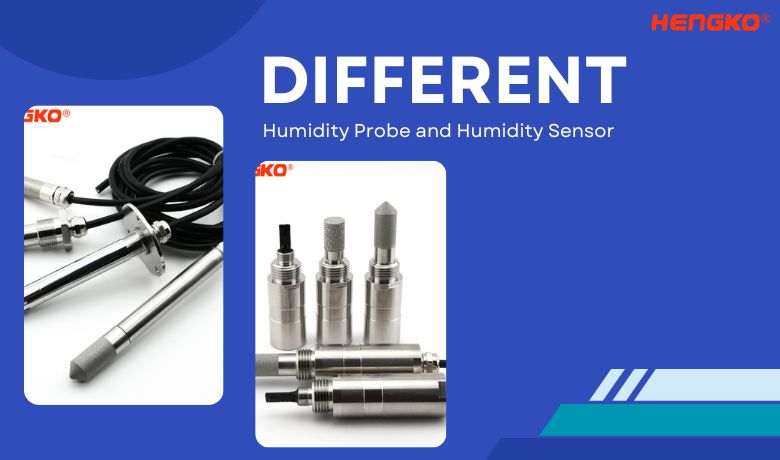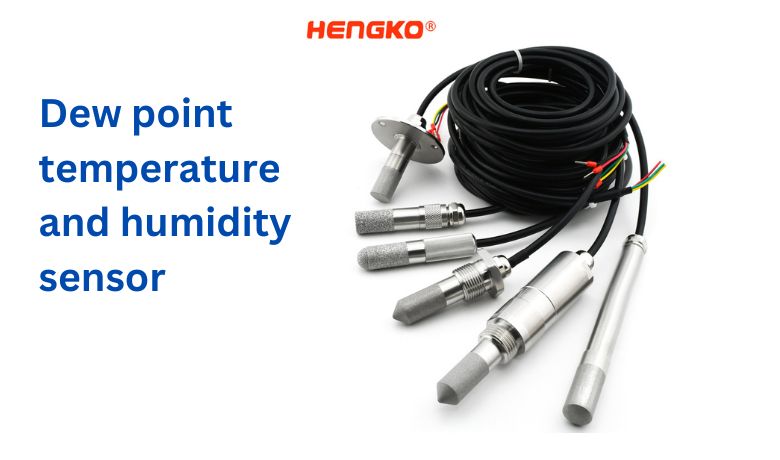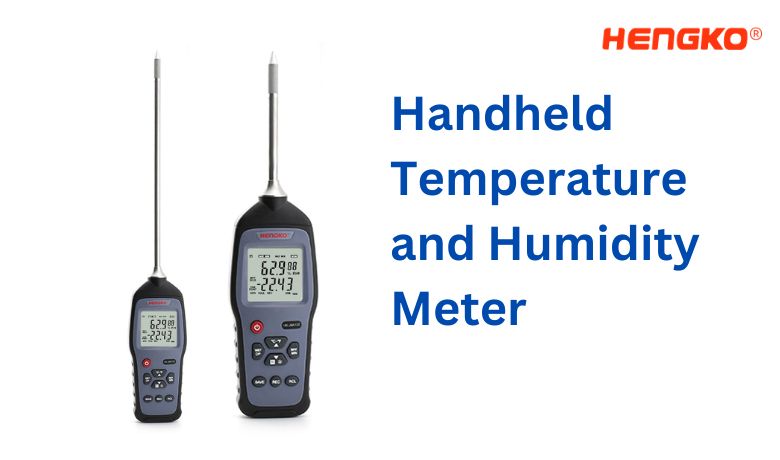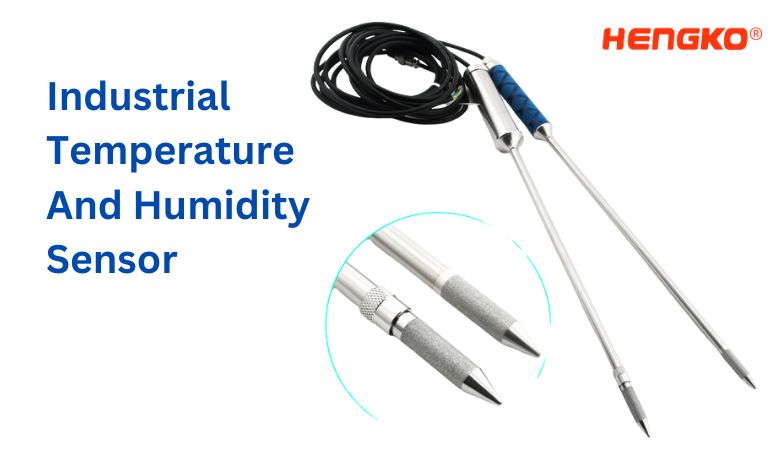
Humidity measurement plays an essential role in various industries like manufacturing, agriculture, HVAC, and even healthcare. It helps maintain quality control, safety, and ensure optimal conditions for different processes. In this blog post, we'll explore the fundamental aspects of humidity, its measurement, and most importantly, the differences between a humidity probe and a humidity sensor. Whether you're a seasoned professional or just starting out in the field, this post will help you understand these crucial tools better.
What is Humidity?
Humidity refers to the amount of water vapor present in the air. It is an essential factor in weather forecasting, HVAC system performance, and maintaining comfort and health in indoor environments. It also plays a vital role in industrial applications, where precise humidity control is often necessary to ensure the quality and safety of products.
1. Definition of Humidity:
Technically, humidity is the amount of water vapor in a gas, most often the air. It's typically expressed as a percentage, representing the current absolute humidity relative to the maximum possible absolute humidity.
2. Role of Humidity in Various Industries:
Humidity is an influential factor in a broad array of industries. For instance, in the textile industry, humidity control is essential to prevent shrinkage and maintain fabric quality. In the healthcare sector, it helps prevent the spread of airborne bacteria and viruses. Other sectors that require humidity control include food and beverage, paper and pulp, construction, and electronics, among others.
3. Different Measures of Humidity:
There are three main ways to measure humidity: absolute, relative, and specific. Absolute humidity refers to the water content in the air, regardless of the temperature. Relative humidity, the most commonly used measure, refers to the amount of humidity in the air compared to the maximum amount the air could hold at the same temperature, expressed as a percentage. Finally, specific humidity is a ratio of the water vapor content of the mixture to the total air content on a mass basis.
Understanding Humidity Probes
Humidity probes are devices used to measure humidity levels in the air accurately. They are usually part of a larger system, working in conjunction with other devices to control and monitor environmental conditions in various applications such as HVAC systems, industrial processes, weather stations, and greenhouses.
1. Components of a Humidity Probe:
A standard humidity probe is composed of a hygrometer (a device that measures humidity) and a thermocouple or resistance temperature detector (RTD) to measure temperature. The probe contains a sensing element, often made from materials like polymer or ceramic, which reacts to changes in the surrounding humidity.
2. How Does a Humidity Probe Work?:
The humidity sensor within the probe absorbs or desorbs water vapor as the relative humidity increases or decreases. This absorption or desorption changes the electrical resistance or capacitance of the sensor, which can be measured and converted into a humidity reading. want to know more details, you can check as following.
3. Types of Humidity Probes:
Various types of humidity probes are available, each with their own specifications and best-use cases. Some examples include high-temperature humidity probes, which are used in environments with extreme temperatures, and 4-20mA humidity probes, which are commonly used in industrial applications for long-distance signal transmission.
4. Calibration of Humidity Probes:
Calibration is essential to maintain the accuracy of a humidity probe. Humidity probe calibration involves comparing the readings of the device to those of a known standard or set of standards under controlled conditions. This process ensures the probe consistently delivers accurate and reliable data.

How do Humidity Probes Work ?
Humidity probes work on the principle of measuring the change in electrical capacitance or resistance to accurately determine the relative humidity in the atmosphere.
Here's a step-by-step explanation of how most humidity probes work:
1. Sensing Element:
The crucial part of any humidity probe is the sensing element, which is often a thin film of polymer or ceramic coated with metal electrodes. This film absorbs or desorbs water vapor from the air surrounding it, which alters the electrical properties of the film. The most common types of humidity sensors are capacitive and resistive sensors.
2. Capacitive Humidity Sensors:
In capacitive sensors, the sensing element is a capacitor with a dielectric layer that absorbs or releases water vapor. The amount of water absorbed by the dielectric changes its capacitance, which is a measure of the electric charge separated in the device. Because the dielectric constant (capacitance) of water is much larger than that of the other materials in the sensor, even small amounts of absorbed water result in significant changes in capacitance. The sensor measures these changes and converts them into relative humidity readings.
3. Resistive Humidity Sensors:
Resistive sensors, on the other hand, work by measuring the change in electrical resistance of a hygroscopic (water-attracting) material. As the material absorbs water, it becomes more conductive, and its resistance decreases. The sensor measures this change in resistance and converts it into a relative humidity reading.
4. Conversion to Humidity Reading:
The changes in either capacitance or resistance are then converted into voltage or current signals by the probe's built-in circuitry. These signals are further converted into digital readings by an analog-to-digital converter.
5. Temperature Compensation:
Because the temperature of the environment can also affect humidity readings, most probes include a temperature sensor. This allows the probe to adjust its humidity readings based on the current temperature, ensuring more accurate results.
6. Data Transmission:
Once the humidity level has been measured and converted into an electrical signal, this information can be transmitted to a display or a data logging system for monitoring or analysis.
Through these steps, humidity probes can provide real-time, accurate measurements of humidity, which are critical in a wide range of industries, including HVAC, weather forecasting, agriculture, and more.
Introduction to Humidity Sensors
While humidity probes are often integrated systems used for precise environmental measurements, humidity sensors are the primary components in those systems that directly interact with the environment to detect changes in humidity levels.
1. What is a Humidity Sensor?:
A humidity sensor, or hygrometer, is an electronic device that measures the amount of water vapor in the air, soil, or confined spaces.
2. Working Principle of Humidity Sensors:
Humidity sensors work by detecting changes in electrical resistance or capacitance that result from varying humidity levels. These changes are then converted into digital readings representing the percentage of relative humidity.
3. Types of Humidity Sensors:
There are several types of humidity sensors, including capacitive, resistive, and thermal conductivity. Each type has its own advantages and is best suited to certain applications.
4. Humidity Sensor Probes:
Humidity sensor probes are devices that integrate humidity sensors. They include additional elements like protective housings or circuitry for signal processing, making them ready for direct use in various applications.
5. Role of Humidity Sensors in Different Applications:
Humidity sensors are used across many industries, including HVAC to monitor indoor air quality, in meteorology for weather forecasting, in the agricultural industry for irrigation control, and in industrial processes where maintaining specific humidity levels is crucial for product quality and safety.
Difference Between Humidity Probes and Humidity Sensors
While the terms "humidity probe" and "humidity sensor" are often used interchangeably, they refer to two different, albeit closely related, concepts. Understanding the difference between these two devices can help you choose the right tool for your specific humidity measurement needs.
-
Design and Composition: A humidity sensor is the core component responsible for detecting and measuring humidity levels. On the other hand, a humidity probe typically houses a humidity sensor within a protective casing, and it often includes additional elements like a temperature sensor and circuitry for data processing and output.
-
Applications: Both humidity sensors and probes are used in various applications, ranging from HVAC systems to weather forecasting. However, due to their more rugged and often more sophisticated design, humidity probes are typically more suited for industrial, high-temperature, or outdoor applications where they might be exposed to harsh conditions.
-
Integration: Humidity sensors, being the primary measuring element, are often integrated into a wide array of devices - from simple handheld hygrometers to advanced weather forecasting equipment. Humidity probes, being more application-specific, are typically designed to be easily integrated into larger monitoring or control systems.
-
Functionality: Humidity sensors primarily focus on the detection and measurement of humidity. Conversely, humidity probes usually offer additional functionalities, such as temperature measurement or direct signal output for control purposes, thanks to their integrated design.
Choosing Between a Humidity Probe and a Humidity Sensor
Deciding whether to use a humidity probe or a humidity sensor will depend on your specific needs, the nature of your project, and the environment in which the device will be used.
-
Understanding Your Requirements: First, you need to define the specific needs of your project. If you only need to measure humidity, a simple humidity sensor might suffice. However, if you need additional measurements or functionalities, a humidity probe may be the better choice.
-
Considering the Application Environment: The environment in which the device will be used can also influence your choice. For rugged or harsh conditions, a humidity probe, which is typically designed to withstand such environments, may be more suitable.
-
Budget Considerations: Cost can be another determining factor. Humidity sensors are usually less expensive than humidity probes due to their simpler design and functionality. However, keep in mind that the additional features and robustness of a humidity probe can provide more value in the long run, particularly for industrial applications.
-
Technical Support and Maintenance: Consider the availability of technical support and the ease of maintenance for the device. A humidity probe might require more advanced technical support due to its complex design, but it may offer easier maintenance, especially models with replaceable sensor elements.
-
Accuracy and Precision: Lastly, take into account the device's accuracy and precision. High-quality humidity probes and sensors can both offer excellent accuracy, but certain probe models might have superior performance due to integrated temperature compensation or advanced calibration options.
Case Studies: Utilizing Humidity Probes and Sensors in Various Industries
Understanding the practical application of humidity probes and sensors across different industries can provide valuable insights into their functionalities and benefits. Here are a few examples of how these devices are used in real-world scenarios.
1. HVAC Systems:
Humidity plays a crucial role in heating, ventilation, and air conditioning (HVAC) systems. Humidity sensors in HVAC systems ensure a comfortable, healthy, and energy-efficient indoor environment by maintaining optimal humidity levels. Meanwhile, humidity probes are often used in larger industrial HVAC systems where robustness and additional functionalities, such as temperature measurement, are necessary.
2. Agriculture and Greenhouses:
Farmers and greenhouse operators rely heavily on humidity probes for maintaining ideal growing conditions. These probes, often integrated with automated systems, help control irrigation, ventilation, and heating based on humidity and temperature measurements, promoting optimal plant growth.
3. Food and Beverage Industry:
Humidity control is critical in the food and beverage industry to ensure product quality and safety. For example, in bakery applications, humidity sensors ensure the right moisture content in the baking environment, impacting the texture and quality of the bread. In beverage production, like breweries, humidity probes are used for more robust applications such as fermentation process control.
4. Pharmaceuticals:
Both humidity sensors and probes play a significant role in the pharmaceutical industry, where strict environmental control is necessary. They are used in research labs, production areas, and storage facilities to ensure product efficacy, safety, and shelf life.
5. Weather Forecasting:
Humidity measurement is vital in meteorological applications. While humidity sensors are commonly found in weather stations, humidity probes are used in more demanding outdoor conditions due to their ruggedness and ability to provide precise readings even in harsh weather.
6. Greenhouses and Agriculture
In agriculture, particularly within greenhouses, humidity probes and sensors can help manage the plant growing environment by monitoring and controlling the moisture in the air. By maintaining the appropriate humidity levels, growers can prevent issues such as plant diseases and enhance overall crop yield.
7. Museums and Art Galleries
In museums and art galleries, humidity control is crucial to preserve delicate artifacts and artwork. If the humidity is too high, mold or mildew might grow, causing irreversible damage. If it's too low, it may lead to the drying out and cracking of materials like paint and wood. By accurately monitoring humidity levels, institutions can better preserve their collections.
8. Data Centers
Data centers need to maintain a certain humidity level to ensure the optimal performance of servers and other equipment. Too much humidity can lead to condensation and corrosion, while too little can cause static electricity buildup. Humidity probes and sensors can provide real-time data, enabling immediate adjustments to keep the center running efficiently.
In each of these applications, humidity probes and sensors can provide accurate, real-time data, enabling informed decision-making and efficient control over the environment. This helps industries ensure the quality of their products, the comfort of their environments, the efficiency of their processes, and the preservation of their assets.

Future Developments in Humidity Measurement Technology
As the importance of humidity measurement in various sectors continues to grow, so does the technology behind humidity sensors and probes.
-
Advancements in Sensor Technology: Miniaturization and increased accuracy are key trends in humidity sensor development. Sensors are becoming smaller, more energy-efficient, and more accurate, enabling their integration into a wide variety of devices, from smartphones to industrial equipment.
-
Smart Probes and IoT: The rise of the Internet of Things (IoT) is influencing the development of 'smart' humidity probes. These probes can connect to networks, allowing for real-time data monitoring and automated control of systems based on humidity readings. This technology is particularly beneficial for large-scale or remote operations, such as agriculture or environmental monitoring.
-
Hybrid Sensing Solutions: More and more, we're seeing humidity probes that integrate other types of sensors, providing all-in-one monitoring solutions. For instance, some probes now include not just a humidity sensor but also temperature, pressure, and even gas sensors.
-
Improved Materials and Design: The development of new materials and design improvements is leading to more robust and durable humidity probes that can withstand extreme conditions. This is crucial for industries such as oil and gas, where equipment must operate reliably in particularly harsh environments.
In conclusion, both humidity probes and sensors play vital roles across a range of industries. Understanding their differences, functionalities, and the evolving technology can help you make an informed decision for your specific humidity measurement needs.
FAQ
1. What is a humidity probe?
A humidity probe is a device designed to measure relative humidity levels in a given environment. It typically consists of a probe housing, a sensor, and a means for transmitting the sensor readings to a data logger or control system. The sensor within the probe is sensitive to changes in humidity, and its readings are converted into digital or analog signals that can be interpreted by a control system or operator. Some humidity probes also include temperature sensors, as temperature can significantly affect relative humidity readings.
2. How does a temperature and humidity sensor work?
A temperature and humidity sensor is a device that measures both the temperature and relative humidity of an environment. These two measurements are interconnected, as the amount of water vapor air can hold is dependent on its temperature. The sensor often uses a capacitive or resistive method to measure humidity, with the sensor's resistance or capacitance changing with the humidity level. The temperature is typically measured using a thermistor or similar temperature-sensitive component.
3. What are the main differences between a humidity probe and a humidity sensor?
The primary difference between a humidity probe and a humidity sensor is in their design and intended use. A humidity sensor is often a small component designed to be integrated into other devices, such as HVAC systems, weather stations, or home appliances. A humidity probe, on the other hand, is a more robust device, often designed for industrial use or for situations where the sensor may need to be inserted into a material or environment, such as soil or a manufacturing process.
4. When should I use a humidity probe instead of a humidity sensor?
The choice between a humidity probe and a sensor depends largely on your specific application. If you need to measure humidity in a harsh or inaccessible environment, a humidity probe is often the better choice. These devices are designed to withstand more extreme conditions and can be inserted directly into the environment or material being measured. On the other hand, if you're integrating a humidity measurement function into an existing system or product, a humidity sensor may be more appropriate.
5. How accurate are humidity probes and sensors?
The accuracy of humidity probes and sensors varies widely depending on the quality and type of the device. High-quality devices from reputable manufacturers can often achieve accuracy levels of ±2% relative humidity or better. It's important to note that accuracy can also depend on correct calibration and appropriate use, so always follow the manufacturer's instructions.
6. How do I maintain a humidity probe or sensor?
Proper maintenance of a humidity probe or sensor involves regular cleaning and calibration. Over time, dust, dirt, or other contaminants can accumulate on the sensor, potentially affecting its accuracy. Regular cleaning, as specified by the manufacturer, can help prevent this. Likewise, regular calibration can ensure the device continues to provide accurate readings over time.
7. Can a humidity probe or sensor measure other parameters?
Yes, many humidity probes and sensors are also capable of measuring other environmental parameters, most commonly temperature. Some devices may also be capable of measuring parameters such as atmospheric pressure, dew point, or specific types of gas concentrations.
8. Are there wireless humidity probes or sensors?
Yes, there are wireless humidity probes and sensors available on the market. These devices can transmit their readings wirelessly to a data logger or control system, making them ideal for use in large facilities or for remote monitoring applications. Some of these wireless devices are even compatible with IoT platforms, allowing for real-time monitoring and data analysis.
9. How to read temp and humidity probe ?
Reading a temperature and humidity probe involves a simple process, often made easy by the digital display provided with many modern sensors. Here's a step-by-step guide:
1. Positioning the Probe: To start with, ensure the probe is positioned correctly in the environment you want to measure. It should be placed away from direct sunlight or any other heat sources that may interfere with accurate readings. Also, the sensor should be positioned in a location with adequate airflow for better accuracy.
2. Powering On: Power on the device. Many temperature and humidity probes are battery-powered and have a power button to turn on the device. Some devices may require a wired connection to a power source.
3. Reading the Display: Once the device is powered on, the display should start to show the current temperature and humidity levels. Most devices display the temperature in degrees Celsius or Fahrenheit and the humidity as a percentage (%RH), which stands for Relative Humidity. For example, a reading of 70%RH means that the air contains 70% of the maximum amount of moisture it can hold at the current temperature.
4. Using the Buttons: Most devices also come with buttons that allow you to switch between different units of measurement or to store and recall previous readings.
5. Interpreting the Readings: To interpret the readings, you'll need to understand what constitutes 'normal' temperature and humidity levels for your specific application. For instance, in a home environment, a comfortable temperature is generally around 20°C to 22°C (68°F to 72°F), and a healthy relative humidity level is typically between 30% and 50%.
6. Data Logging: Some advanced temperature and humidity probes offer the feature of data logging. This feature allows you to track and record the temperature and humidity over time, which can be beneficial for trend analysis or for maintaining compliance in certain industries.
7. Software Integration: Some probes can be integrated with software applications that provide more detailed data analysis and reporting capabilities. These applications may also allow you to set alarms for when the temperature or humidity goes outside of a specified range.
10. How to calibrate humidity sensor ?
Calibration of a humidity sensor is crucial to ensure its accurate performance over time. Various factors such as changes in environmental conditions, aging, and physical stress can affect the sensor's accuracy, so periodic calibration is recommended. Here's a basic step-by-step guide on how you can calibrate a humidity sensor. However, always refer to the user manual provided by your sensor manufacturer for specific instructions.
1. Gather Materials: You will need a reference hygrometer (a device that measures humidity and is already calibrated), distilled water, two sealable containers, and table salt.
2. Creating the Calibration Environment:
-
For 75% Relative Humidity: Pour some table salt into one of the containers. Then, add enough distilled water to make the salt slurry, but ensure the salt isn't completely dissolved. Place your sensor and the reference hygrometer into the container, making sure neither are touching the salt slurry. Seal the container.
-
For 33% Relative Humidity: Fill the other container with distilled water. Place your sensor and the reference hygrometer in this container, again making sure that neither device is touching the water. Seal the container.
3. Wait: Allow both containers to sit undisturbed for at least 12 to 24 hours. This gives them time to reach equilibrium, at which point the sealed environment inside each container will reach a stable humidity level—75% in the salt slurry container and 33% in the water container.
4. Compare Readings: After the waiting period, compare the readings from your humidity sensor with the readings from the reference hygrometer in both containers. Your sensor's readings should match the known humidity levels in the containers (75% and 33%).
5. Adjust as Needed: If your sensor's readings are off, use the sensor's calibration function to adjust its readings. The specific steps for this will depend on your device's make and model.
6. Repeat as Necessary: After calibrating, you can repeat steps 2 to 5 to ensure that the sensor is now providing accurate readings. If not, you may need to recalibrate or consider replacing the sensor if it continues to provide inaccurate measurements.
7. Documentation: Keep a record of all calibration processes and results. This will help in troubleshooting and maintaining compliance with quality standards if necessary.
If you're still feeling a bit unsure about the differences between humidity probes and sensors, or if you have any other questions regarding humidity measurement, don't hesitate to get in touch! Our team at HENGKO has extensive experience and expertise in this field. We'd be delighted to help guide you through the process of selecting the best product for your needs.
Whether you're just beginning your journey in humidity control or are an expert looking to optimize your system, you can reach us at ka@hengko.com. We're here to help you ensure that you get the most accurate, reliable, and efficient humidity measurements possible. Let's explore the world of humidity control together!
Don't delay - reach out to us today. We're looking forward to hearing from you!
Post time: Jul-11-2023





